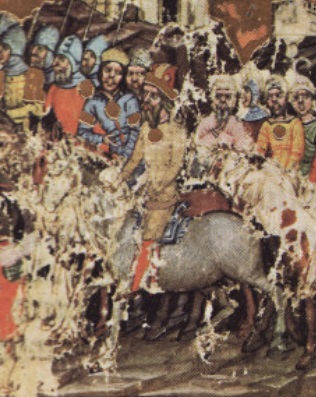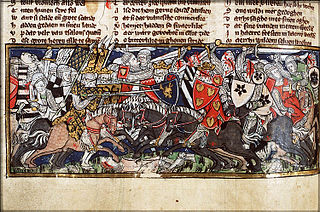Related Research Articles

The Huns were a nomadic people who lived in Central Asia, the Caucasus, and Eastern Europe between the 4th and 6th centuries AD. According to European tradition, they were first reported living east of the Volga River, in an area that was part of Scythia at the time. By 370 AD, the Huns had arrived on the Volga, causing the westwards movement of Goths and Alans. By 430, they had established a vast, but short-lived, empire on the Danubian frontier of the Roman empire in Europe. Either under Hunnic hegemony, or fleeing from it, several central and eastern European peoples established kingdoms in the region, including not only Goths and Alans, but also Vandals, Gepids, Heruli, Suebians and Rugians.

Procopius Anthemius was the Western Roman emperor from 467 to 472. Born in the Eastern Roman Empire, Anthemius quickly worked his way up the ranks. He married into the Theodosian dynasty through Marcia Euphemia, daughter of Eastern emperor Marcian. He soon received a significant number of promotions to various posts, and was presumed to be Marcian's planned successor. However, Marcian's sudden death in 457, together with that of Western emperor Avitus, left the imperial succession in the hands of Aspar, who instead appointed Leo, a low-ranking officer, to the Eastern throne, probably out of fear that Anthemius would be too independent. Eventually, this same Leo designated Anthemius as Western emperor in 467, following a two-year interregnum that started in November 465.

Bleda was a Hunnic ruler, the brother of Attila the Hun.

The Hunnic language, or Hunnish, was the language spoken by Huns in the Hunnic Empire, a heterogeneous, multi-ethnic tribal confederation which invaded Eastern and Central Europe, and ruled most of Pannonian Eastern Europe, during the 4th and 5th centuries CE. A variety of languages were spoken within the Hun Empire. A contemporary report by Priscus has that Hunnish was spoken alongside Gothic and the languages of other tribes subjugated by the Huns.
Charaton was one of the first kings of the Huns.

Uldin, also spelled Huldin is the first ruler of the Huns whose historicity is undisputed.

Balamber was ostensibly a chieftain of the Huns, mentioned by Jordanes in his Getica. Jordanes simply called him "king of the Huns" and writes the story of Balamber crushing the tribes of the Ostrogoths in the 370s; somewhere between 370 and more probably 376 AD.

Laudaricus was a prominent Hunnic chieftain and general active in the first half of the 5th century.

The history of the Huns spans the time from before their first secure recorded appearance in Europe around 370 AD to after the disintegration of their empire around 469. The Huns likely entered Western Asia shortly before 370, from Central Asia: they first conquered the Goths and the Alans, pushing a number of tribes to seek refuge within the Roman Empire. In the following years, the Huns conquered most of the Germanic and Scythian tribes outside of the borders of the Roman Empire. They also launched invasions of both the Asian provinces of Rome and the Sasanian Empire in 375. Under Uldin, the first Hunnic ruler named in contemporary sources, the Huns launched a first unsuccessful large-scale raid into the Eastern Roman Empire in Europe in 408. From the 420s, the Huns were led by the brothers Octar and Ruga, who both cooperated with and threatened the Romans. Upon Ruga's death in 435, his nephews Bleda and Attila became the new rulers of the Huns, and launched a successful raid into the Eastern Roman Empire before making peace and securing an annual tribute and trading raids under the Treaty of Margus. Attila appears to have killed his brother, and became sole ruler of the Huns in 445. He would go on to rule for the next eight years, launching a devastating raid on the Eastern Roman Empire in 447, followed by an invasion of Gaul in 451. Attila is traditionally held to have been defeated in Gaul at the Battle of the Catalaunian Fields, however some scholars hold the battle to have been a draw or Hunnic victory. The following year, the Huns invaded Italy and encountered no serious resistance before turning back.
Aigan or Aïgan was a Hun general serving as a cavalry commander for the Byzantine Empire, active in the early 6th century.
Kursich was a Hun general and royal family member. He led a Hunnish army in the Hunnic invasion of Persia in 395 AD.
Mamas was a Hun royal family member who was impaled by Attila in Thrace.
Berichus or Berik was a Hun nobleman, ambassador, and lord, said to have "ruled over many villages".
Chelchal was a Hun commander serving as lieutenant general under the Byzantine Empire.
Zolban or Zolbon was a Hun general fighting for the Byzantine Empire. He fought alongside fellow Hun commander Sigizan against the Isaurians in 493 AD.
Tarrach was a Hun military officer for the East Roman Empire. He was the assassin of the officer Cyril. Tarrach was credited as the "fiercest of the Huns".
Emnetzur was a Hun nobleman and a blood relative of Attila.
Ultzindur was a Hun nobleman and a blood relative of Attila.
Althias was a Hun military commander in the Byzantine Empire. He is noted for defeating Iaudas, king of the Moors, and his army with just 70 men.
Theodimundus or Theudimund(Latin: Theodimundus; Greek: Θευδιμούνδος; fl. 541) was a Byzantine official of Barbarian origins.
References
- 1 2 Martindale, John R., ed. (1980). The Prosopography of the Later Roman Empire: Volume II, AD 395–527. Cambridge: Cambridge University Press. p. 571. ISBN 0-521-20159-4.
- 1 2 3 Hodgkin, Thomas (1892). Italy and Her Invaders Volume 2. Clarendon Press. pp. 452–453. Retrieved 28 October 2022.
- ↑ Kim, Hyun Jin (2015). The Huns. Taylor & Francis. ISBN 9781317340904 . Retrieved 28 October 2022.
- ↑ Maenchen-Helfen, Otto J. "The World of the Huns. Chapter IX. Language". www.kroraina.com. Retrieved 28 October 2022.
- ↑ Kim, Hyun Jin (2013). The Huns, Rome and the Birth of Europe. Cambridge University Press. p. 204. ISBN 9781107009066 . Retrieved 28 October 2022.
- 1 2 Henning, Walter Bruno (1970). Boyce, Mary; Gershevitch, Ilya (eds.). W. B. Henning Memorial Volume. Lund Humphries. ISBN 9780853312550 . Retrieved 13 November 2022.